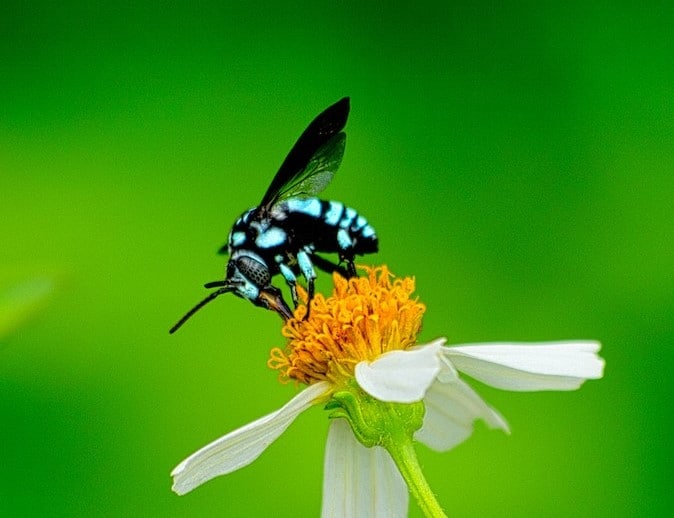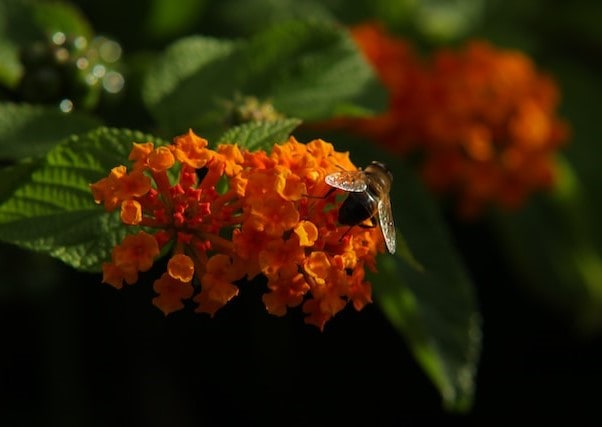Sweat Bees, also known as Halictid Bees, are one of the largest families of bees and are from the family Halictidae.
The family Halictidae is a diverse group with over 4,000 bee species. They are so diverse that these species vary in behavior, size, shape, and color.
What are Sweat Bees?

This bee family comprises solitary, semi-social, and social bees.
One of the solitary bees in this family is the Augochlora Pura (Say), also known as the pure gold-green sweat bee. On the other hand, the Halictus ligatus and the Lasioglossum malachurum are social Halictid species.
With the exception of honey bees, these bees are more abundant compared to other bee species. Sweat bees are found almost everywhere in the world. Most Sweat Bees abound in places with temperate temperatures.
Most Halictidae species nest in the ground (ground bees), while other species prefer to live in wood or wooden structures.
Sweat bees vary greatly in appearance. They can be dull or metallic colored.
Some species may be dull brown or black. Several species can be metallic blue, metallic green, or even metallic purple and metallic black.
Most of these bees are slender in size, but there are a few that are robust. They can be as small as 1/3 of an inch long or even smaller.
No matter the diversity, most Halictid Bees are small and non-aggressive.
What’s in a Name?
Why are they called Sweat Bees?
One common characteristic of Halictid Bees is that they easily get attracted to perspiration or sweat.
As with most bees, Sweat Bees eat nectar and pollen. In doing so, they pollinate flowers in the process.
Yet, these bees have to drink and need some salt supplements. Hence, their attraction to human sweat and the common name Sweat Bees.
Are Sweat Bees Beneficial?
Sweat bees are among the best bees when it comes to buzz pollination. They are one of the smallest buzz pollinators and are beneficial in pollinating small flowers that larger bees most often overlook.
These bees visit tiny flowers and hold on to that top part of the stamen where pollen is found, called the anther. The bees then start vibrating their muscles on the wings, causing pollen to be scattered around. Released and scattered pollens land on other flowers, causing cross-pollination.
These bees are important pollinators in our gardens and our ecosystem.
Excellent Pollinators

There are lots of flowers and flowering plants that rely on buzz pollination to pollinate and produce fruits. Without flower pollination, these plants will not be able to produce seeds and fruits.
With the help of different species of bees, farmers and backyard gardeners are able to gather more fruits and a larger harvest. Around 30% of crops in the United States rely on our industrious six-legged friends as pollinators.
Sweat Bees seem to be made for this purpose. They are excellent at this job.
Sweat bees tend to favor wildflowers, fruits, and vegetables. However, a variety of other crops also rely on these bees to pollinate them for a better harvest.
Some flowers are so tiny that larger bees would pass by them. These disregarded flowers are the type that a Sweat Bee would pollinate as no other bees could pollinate them.
Do Sweat Bees Make Honey Like Honeybees?
Sweat bees, unlike honey bees, do not produce honey, at least not at a commercial level.
While some species of sweat bees are social insects just like honey bees, these bees do not produce honey as much as honey bees, which would be good for human consumption.
In this process, the queen sweat bee lays eggs, and worker bees collect pollen and nectar to feed the offspring. The honey these bees can produce is only enough for the colony’s consumption as food.
Why do Sweat Bees Land on You?
By their name, one can deduce that a Sweat Bee lands on a human to get a taste of sweat and drink what your body perspires.
Yes, human sweat attracts a Sweat Bee, inviting it to land on people.
Do Sweat Bees Sting?

A word of caution, though… When one of these bees lands on you, do not try to swat or hurt it, as it might retaliate and sting you. Just like most species, females of this bee family deliver stings that could cause allergic reactions or hurt you.
A gentle sip of human sweat would be enough for them, and they would move away.
It is also seldom that a sweat bee infestation happens. And when it does, a swarm of sweat bees would most likely not go after you, seeping your sweat away!
So there’s really no need to worry about these bees bothering you too much. But if you are indeed bothered, here are some ways to get rid of these Sweat Bees, the natural way!
